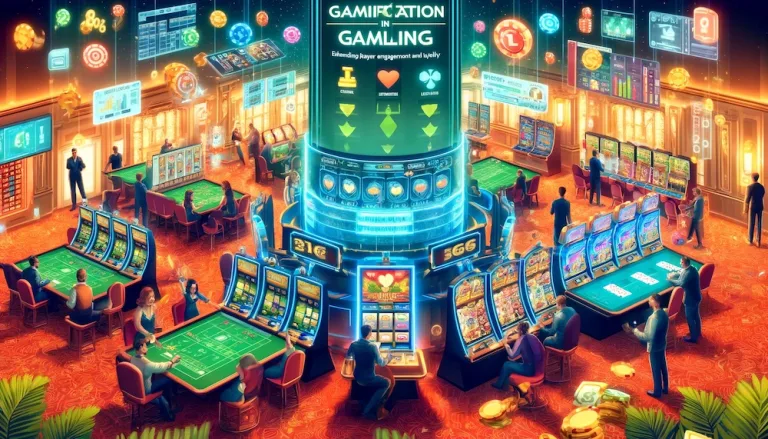Gamification, the integration of game-like elements into non-game contexts, is revolutionizing the gambling industry. By incorporating interactive and rewarding experiences, casinos are not only enhancing player engagement but also boosting loyalty. This innovative approach is reshaping how players interact with gambling platforms, making the experience more dynamic and enjoyable. In this article, we delve into the impact of gamification on gambling, its benefits, and how it is changing the future of the industry.
What is Gamification in Gambling?
Gamification in gambling involves incorporating elements commonly found in games, such as points, levels, leaderboards, challenges, and rewards, into gambling platforms. These elements create a more engaging and interactive environment, encouraging players to participate more actively and stay longer on the platform. Gamification taps into players’ natural desire for competition, achievement, and recognition, making the gambling experience more enjoyable and immersive.
Key Elements of Gamification
Points and Levels
Players earn points for completing various activities, such as placing bets, winning games, or participating in challenges. Accumulating points can lead to leveling up, unlocking new features, or receiving rewards. This progression system keeps players motivated and engaged as they strive to reach higher levels and gain more benefits.
Leaderboards
Leaderboards display the rankings of players based on their achievements and activities. This competitive element encourages players to improve their performance and climb the ranks. Leaderboards can be weekly, monthly, or overall, and often come with rewards for top performers, further incentivizing participation.
Challenges and Missions
Challenges and missions provide specific tasks for players to complete, adding variety and excitement to the gambling experience. These tasks can range from winning a certain number of games to achieving specific in-game milestones. Completing challenges often results in earning points, badges, or other rewards, keeping the gameplay fresh and engaging.
Rewards and Badges
Rewards and badges are given for completing challenges, leveling up, or achieving specific milestones. These rewards can be in the form of free spins, bonus cash, exclusive access to certain games, or even physical prizes. Badges serve as symbols of achievement and status, motivating players to collect them and show off their accomplishments.
Benefits of Gamification in Gambling
Increased Player Engagement
Gamification significantly enhances player engagement by making the gambling experience more interactive and enjoyable. The incorporation of game-like elements keeps players entertained and motivated, reducing boredom and encouraging longer play sessions. This increased engagement can lead to higher player retention rates and increased revenue for operators.
Enhanced Player Loyalty
By providing a rewarding and enjoyable experience, gamification fosters player loyalty. Players are more likely to return to a platform where they feel challenged, recognized, and rewarded. Loyalty programs that incorporate gamification elements, such as VIP tiers and exclusive rewards, further enhance the sense of belonging and commitment among players.
Improved User Experience
Gamification improves the overall user experience by adding depth and variety to the gambling platform. The interactive and rewarding nature of gamified elements creates a more immersive and satisfying experience for players. A positive user experience is crucial for attracting new players and retaining existing ones.
Data Insights and Personalization
Gamification provides valuable data insights into player behavior and preferences. By tracking players’ activities and achievements, operators can gain a better understanding of what motivates and engages their audience. This data can be used to personalize the gambling experience, offering tailored rewards, challenges, and promotions that resonate with individual players.
Examples of Gamification in Gambling
Slot Tournaments
Many online casinos host slot tournaments, where players compete against each other to achieve the highest score on specific slot games within a set timeframe. Participants earn points based on their performance, and top scorers are rewarded with prizes. These tournaments add a competitive and social element to slot gaming, enhancing the overall experience.
Loyalty Programs
Loyalty programs that incorporate gamification elements, such as points, levels, and rewards, are common in online casinos. Players earn points for their activities and can exchange them for bonuses, free spins, or other perks. VIP programs often have multiple tiers, with each level offering increasingly valuable rewards and benefits, encouraging players to stay active and loyal.
Mission-Based Games
Some online casinos offer mission-based games, where players complete specific tasks or objectives to earn rewards. These missions can include challenges like winning a certain number of hands in poker or achieving a particular combination in a slot game. Completing missions adds an extra layer of excitement and purpose to the gameplay.
Challenges and Considerations
Balancing Engagement and Responsibility
While gamification can enhance player engagement, it is essential to balance it with responsible gambling practices. Operators must ensure that gamified elements do not encourage excessive gambling or exploit vulnerable players. Implementing features such as self-exclusion, spending limits, and time-out options can help promote responsible gaming.
Regulatory Compliance
Gamification elements must comply with gambling regulations and standards. Operators need to ensure that their gamification strategies are transparent, fair, and do not mislead players. Adhering to regulatory guidelines is crucial for maintaining trust and credibility in the gambling industry.
The Future of Gamification in Gambling
Integration with Emerging Technologies
The future of gamification in gambling will likely involve integration with emerging technologies such as virtual reality (VR) and augmented reality (AR). These technologies can create even more immersive and interactive gamified experiences, taking player engagement to new heights. Additionally, advancements in artificial intelligence (AI) can enhance personalization and offer more dynamic and adaptive gamification elements.
Expanding Gamification Beyond Casinos
While gamification is currently popular in online casinos, its potential extends beyond traditional gambling platforms. Sports betting, eSports, and fantasy sports can also benefit from gamification, offering players a more engaging and rewarding experience. The principles of gamification can be applied across various forms of gambling, creating a more unified and entertaining ecosystem.
Conclusion
Gamification is transforming the gambling industry by enhancing player engagement and loyalty through interactive and rewarding experiences. By incorporating elements such as points, levels, leaderboards, and challenges, casinos can create a more dynamic and enjoyable environment for players. As technology continues to evolve, the future of gamification in gambling promises even more innovative and immersive experiences. Whether you’re a casual player or a seasoned gambler, gamification offers a new and exciting way to enjoy your favorite games.

David Garato is a luminary in gaming journalism, renowned for peeling back the curtain on the gaming world with his witty and insightful commentary. A decade into weaving stories from the pixelated edges of indie games to the expansive universes of AAA titles, David’s work is a thrilling blend of analysis and adventure. When not writing, he’s live-streaming, sharing his gaming exploits with an engaged and growing audience. David doesn’t just write about games; he lives them, making him a trusted guide in the gaming community.


